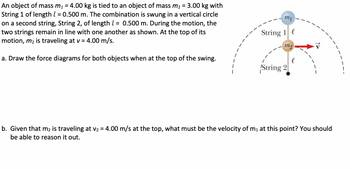Question

Transcribed Image Text:An object of mass m₁ = 4.00 kg is tied to an object of mass m₂ = 3.00 kg with
String 1 of length 1 = 0.500 m. The combination is swung in a vertical circle
on a second string, String 2, of length 1 = 0.500 m. During the motion, the
two strings remain in line with one another as shown. At the top of its
motion, m₂ is traveling at v = 4.00 m/s.
a. Draw the force diagrams for both objects when at the top of the swing.
1
mi
String 1
mo
String 2
b. Given that m2 is traveling at v₂ = 4.00 m/s at the top, what must be the velocity of m₁ at this point? You should
be able to reason it out.
Expert Solution
This question has been solved!
Explore an expertly crafted, step-by-step solution for a thorough understanding of key concepts.
This is a popular solution
Trending nowThis is a popular solution!
Step by stepSolved in 3 steps with 1 images

Knowledge Booster
Similar questions
- A ball of mass 100gr is attached to an 80cm long string and undergoes vertical circular motion. The center of the circle is 3 meters off the ground, as illustrated in the figure below. The ball is swung at the minimum speed necessary to make it over the top without the string going slack. If the string is cut at the instant the ball is at the top of the circle, how far to the left does the ball hit the ground? 80 cm 3 meters m = 100 grarrow_forwardA small object with mass 0.200 kg moves with constant speed in a vertical circle of radius 0.500 m. It takes the object 0.200 s to complete one revolution (a) What is the translational speed of the object? (b) What is the frequency? (c) As the object passes through the lowest point in its motion, what is the direction of the acceleration of the object? upward downward The acceleration is zero and has no direction. (d) As the object passes through the lowest point of its motion, what is the magnitude of the acceleration of the object?arrow_forwardThe earth rotates once per day about an axis passing through the north and south poles, an axis that is perpendicular to the plane of the equator. Assuming the earth is a sphere with a radius of 6.38 x 10' m, determine the speed and centripetal acceleration of a person situated (a) at the equator and (b) at a latitude of 54.0° north of the equator. (a) v= 464 ac= (b) v = Units m/s i 0.03402 Units m/s^2 Units m/s ac= i Units m/s^2 Rearrow_forward
- An astronaut orbiting the Earth is preparing to dock with a Westar VI satellite. The satellite is in a circular orbit 700 km above the Earth's surface, where the free-fall acceleration is 8.28 m/s2. Take the radius of the Earth as 6400 km. Determine the speed of the satellite. x m/s Determine the time interval required to complete one orbit around the Earth, which is the period of the satellite. X minarrow_forwardLength l=0.6m. M is brought to uniform circular motionarrow_forwardA 0.7-kg mass attached to the end of a string swings in a vertical circle (radius = 2.3 m). When the mass is at the lowest point on the circle, the speed of the mass is 15 m/s. What is the magnitude of the force of the string in newtons (i.e. tension in the string) on the mass at this position?arrow_forward
- An airline passenger drops a coin while the plane is moving horizontally at 250 m/s. v = 250 m/sh = 1.3 m How far does the coin travel horizontally in meters with respect to the Earth if it falls 1.3 m?arrow_forwardAn object of mass m; = 4.00 kg is tied to an object of mass m2 = 2.80 kg with String 1 of length e = 0.500 m. The combination is swung in a vertical circular path on a second string, String 2, of length e = 0.500 m. During the motion, the two strings are collinear at all times as shown in the figure. At the top of its motion, m, is traveling at v = 5.90 m/s. String 1 e String 2 (a) What is the tension in String 1 at this instant? (b) What is the tension in String 2 at this instant? N (c) Which string will break first if the combination is rotated faster and faster? O string 1 O string 2arrow_forwardA ball of mass m = 0.275 kg swings in a vertical circular path on a string of length L = 0.850 m as shown. At the lowest point in its vertical path the ball is 1.5 m from the ground. If the string is cut when the ball is at the bottom of the string moving with a speed of 7.5 m/s, how far in the x-direction does the ball move before hitting the ground?arrow_forward
- A ball is tied to a string and whirled in a horizontal circle at a constant 4 revolutions per second. Categorize the kinematic properties according to whether they are constant and zero, constant and nonzero, or not constant in value. v: linear speed (scalar) v→: linear velocity (vector) ar: radial (centripetal) acceleration (scalar) a→r: radial (centripetal) acceleration (vector) ω: angular speed (scalar) ω→: angular velocity (vector) α: angular acceleration (scalar) α→: angular acceleration (vector)arrow_forwardA particle travels in a circular orbit of radius r = 143.8 m. Its speed is changing at a rate of at = 16.1 m/s2 at an instant when its speed is v = 45.3 m/s. What is the magnatude of the total aceleration of the particle in m/s^2?arrow_forward
arrow_back_ios
arrow_forward_ios